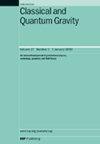推进重力间谍中的故障分类:高级LIGO第四次观测运行的多视图融合与基于注意力的机器学习
IF 3.7
3区 物理与天体物理
Q2 ASTRONOMY & ASTROPHYSICS
引用次数: 0
摘要
激光干涉仪引力波天文台(LIGO)等地面观测站首次成功探测到引力波,标志着我们对宇宙的理解取得了突破。然而,由于进行此类观测所需的前所未有的灵敏度,引力波探测器也会捕捉到被称为故障的破坏性噪声源,这些噪声源可能会与引力波信号混淆或掩盖。为了解决这个问题,一个名为“重力间谍”的社区科学项目将人类的洞察力和机器学习结合起来,对LIGO数据中的故障进行分类。自2017年以来,机器学习分类器集成到该项目中,随着时间的推移,它不断发展,以适应越来越多的故障类。尽管它取得了成功,但由于架构的简单性,在正在进行的LIGO第四次观测运行(O4)中出现了局限性,这导致了较差的泛化和无法有效处理多时间窗口输入。我们提出了一种高级的O4故障分类器。利用之前的观测数据,我们评估了多时间窗口输入的不同融合策略,使用标签平滑来对抗噪声标签,并通过注意模块生成的权重来增强可解释性。我们的新O4分类器显示出改进的性能,并将增强故障分类,帮助正在进行的引力波现象的探索。本文章由计算机程序翻译,如有差异,请以英文原文为准。
Advancing glitch classification in Gravity Spy: multi-view fusion with attention-based machine learning for Advanced LIGO’s fourth observing run
The first successful detection of gravitational waves by ground-based observatories, such as the Laser Interferometer Gravitational-Wave Observatory (LIGO), marked a breakthrough in our comprehension of the Universe. However, due to the unprecedented sensitivity required to make such observations, gravitational-wave detectors also capture disruptive noise sources called glitches, which can potentially be confused for or mask gravitational-wave signals. To address this problem, a community-science project, Gravity Spy, incorporates human insight and machine learning to classify glitches in LIGO data. The machine-learning classifier, integrated into the project since 2017, has evolved over time to accommodate increasing numbers of glitch classes. Despite its success, limitations have arisen in the ongoing LIGO fourth observing run (O4) due to the architecture’s simplicity, which led to poor generalization and inability to handle multi-time window inputs effectively. We propose an advanced classifier for O4 glitches. Using data from previous observing runs, we evaluate different fusion strategies for multi-time window inputs, using label smoothing to counter noisy labels, and enhancing interpretability through attention module-generated weights. Our new O4 classifier shows improved performance, and will enhance glitch classification, aiding in the ongoing exploration of gravitational-wave phenomena.
求助全文
通过发布文献求助,成功后即可免费获取论文全文。
去求助
来源期刊

Classical and Quantum Gravity
物理-天文与天体物理
CiteScore
7.00
自引率
8.60%
发文量
301
审稿时长
2-4 weeks
期刊介绍:
Classical and Quantum Gravity is an established journal for physicists, mathematicians and cosmologists in the fields of gravitation and the theory of spacetime. The journal is now the acknowledged world leader in classical relativity and all areas of quantum gravity.
 求助内容:
求助内容: 应助结果提醒方式:
应助结果提醒方式:


